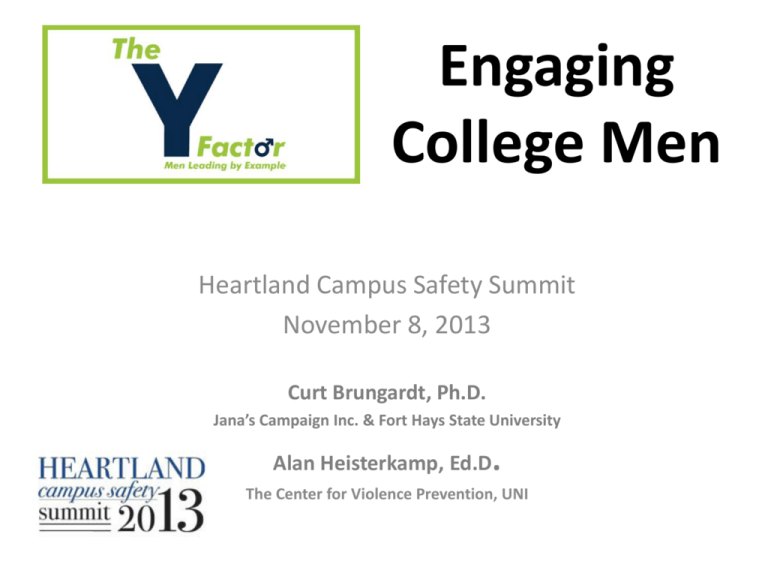
Engaging
College Men
Heartland Campus Safety Summit
November 8, 2013
Curt Brungardt, Ph.D.
Jana’s Campaign Inc. & Fort Hays State University
Alan Heisterkamp, Ed.D.
The Center for Violence Prevention, UNI
The Y Factor-Engaging College Men
Discussion Outline
•
•
•
•
•
•
•
A New Kind of Strength (video)
Why engage men in preventing violence against women
Challenges to engaging men
Defining men’s roles in prevention
What men think (Peter Hart research)
Effective strategies and components in men’s violence prevention
The campus setting: working with men’s groups
(Athletic teams, fraternities, male residential halls/floors, etc.)
• Examples of successful programs/campaigns
• Further discussion and questions
• How can we help
A New Kind of Strength
Growing International Movement
“For many years, women around the world
have led efforts to prevent and end
violence, and today more and more men
are adding their support to the women’s
movement. Men have a crucial role to
play as fathers, friends, decision makers,
and community leaders in speaking out
against violence against women and
ensuring that priority attention is given to
the issue. Importantly, men can provide
positive role models for young men and
boys, based on healthy models of
masculinity.”
Growing International Movement
“There is a growing awareness that men, in
partnership with women, can play a significant
role in ending violence against women. This has
led to an increase in programs and activities
that focus on men’s roles in violence prevention.”
-Alan Berkowitz
Why Engage Men
• Because of the untold harm it causes to women in
men’s lives and the way in which it directly hurts
men
• Because working with men and boys is necessary
• Because there are conflicting signals in what it means
to be a man
• Because what men believe other men think is a
strong determent of how they act
• Because promising strategies and best practices in
engaging men and boys show effective results
• Because many men can and want to help (father,
brother, friend, educator, coach, role model, etc.)
(Men’s Nonviolence Project)
Why Engage Men
“While most men may never use violence, the simple fact is that men
are overwhelming the perpetration of gender-based violence.”
The root causes of gender-based violence can almost exclusively be
narrowed down to two things:
– Fundamental conditions of gender inequality
– Violent, harmful and controlling aspects of masculinity
(White Ribbon Campaign)
Why Engage Men
“Although historically it has been almost entirely women
who have been at the forefront addressing this issue, we
(A Call to Men) think it is essential that men play a
primary role in the solution. To do that, well-meaning
men…men who, for the most part don’t see themselves
as part of the problem…need to get involved.
We believe that preventing domestic and sexual violence
is ultimately the responsibility of men.”
- Tony Porter
Co-Founder, A Call to Men
Challenges to Engaging Men
• Many men (who are nonviolent) don’t see
how this issue personally relates to them.
• Many men do not think violence against
women is a serious issue in our society.
• Many men believe its “other men’s problem”
(men with mental health issues, addictions or
substance use challenges, men from low
income, low education demographics, etc.)
(White Ribbon Campaign)
Challenges to Engaging Men
• Many men just remain silent (the power of
protecting other men)
• Many men and boys are hostage to the outdated
concept of masculinity that a “real man” is tough,
unemotional, powerful, dominate,
uncompromising and in control.
• Many men appear to be caught between knowing
the importance of speaking out and the
unwillingness or perceived lack of knowledge or
skill to intervene.
(White Ribbon Campaign)
Defining Men’s Role in Prevention
• Not personally engaging in violence
• Intervening against the violence of other men
• Addressing the root causes of violence
(Berkowitz)
In terms of engaging men in
prevention efforts, one of the
most powerful ways to generate
empathy and understanding, is
to ask men if they had
experiences of violence, and
how those experiences made
them feel.
(The White Ribbon Campaign)
2000 National Study
Peter Hart Research, 1000 Men
• 21% not actively involved in community efforts
to stop violence against women because no one
had asked them
• 16% didn’t have the time
• 13% reported they didn’t know how to help
• 13% identified reluctance – vilified and
perceived as part of the problem
• 11% thought domestic violence was a private
matter and were uncomfortable to get involved
…men’s willingness to intervene
to prevent sexual assault is
highly correlated with men’s
perception of other men’s
willingness to intervene
(Fabiano et al, 2003).
(The White Ribbon Campaign)
Effective Strategies with Men & Boys
• Correcting men’s misperceptions of each
other
• Document men’s misperceptions of other men
• Address attitudes and beliefs about traditional
masculine values and roles
• Teach bystander strategies to intervene with
other men and boys.
Berkowitz, Schewe, 2003
Men’s Athletics
Engaging Men on Campus
Successful Programs
http://www.acalltomen.org/
http://www.whiteribbon.ca/
http://www.mencanstoprape.org/
http://mensworkinc.com/
Successful Programs
http://www.jacksonkatz.com/mvp.html
http://www.futureswithoutviolence.org
/section/our_work/men_and_boys/_co
aching_leadership/
http://www.menengage.org/
http://www.preventconnect.org/2012/
05/iowa-mens-action-network/
Further Discussion and Questions
How can we help?
Heisterkamp
& Brungardt
alan.heisterkamp@uni.edu
cbrungar@fhsu.edu
When developing and promoting
programming for men and boys
aimed at preventing violence
against women, harmful aspects
of masculinity, homophobia,
sexism, and other forms of
gender-based violence must be
addressed.
(The White Ribbon Campaign)







